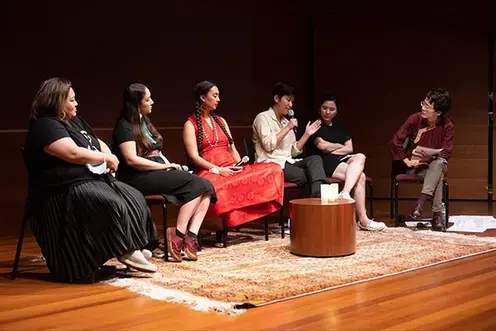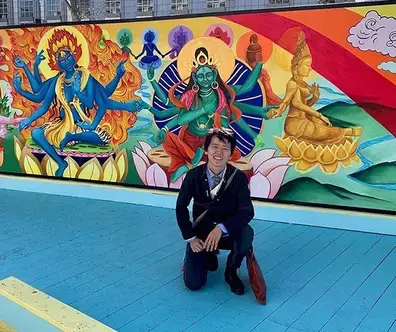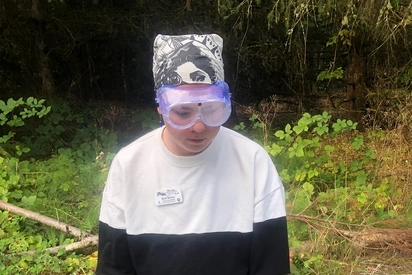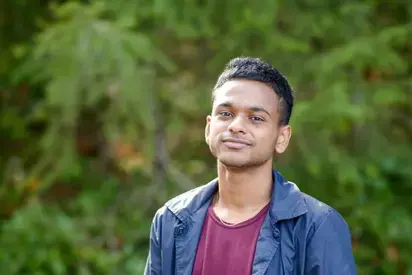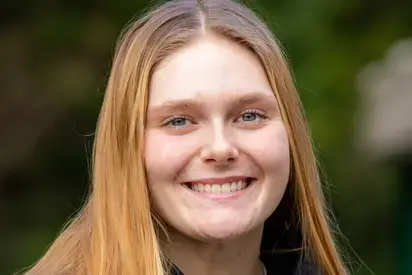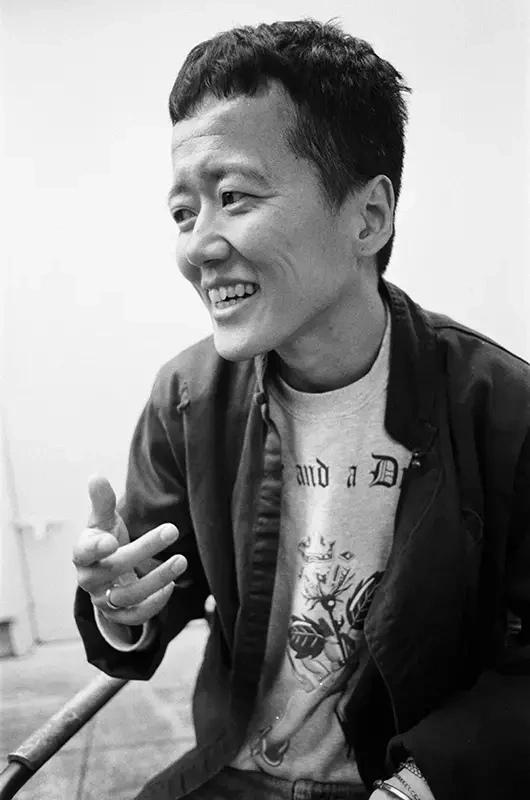
Alumni Programs is denoted as AP and Tenzin M. Paldron is denoted as TP in this interview.
AP: Tell us about yourself, who is Tenzin Mingyur Paldron?
TP: It can take us time to know who we are and see the bigger picture of our earlier experiences. I’m someone who was the first Tibetan child here in Olympia, WA. I didn’t consciously think about this until my twenties. When I came to the US in 1989, there were fewer than 300 Tibetans here. No one told us this, but you can find it now on a Wiki page for the Tibetan American immigration timeline. Prior to my immigration I was born under refugee status in New Delhi, India. The cultural context of my early childhood was vastly different from the culture and community I joined when I moved to the US.
Speaking to who I am right now, I’m someone who really values my friends and learning about the histories and present moments of different communities. I continue to develop my understanding of myself as a Tibetan person and transgender, trans masculine person.
AP: What brought you to Evergreen?
TP: I graduated from a public high school in Seattle and had some serious events take place in my life before then. If life had gone a different way, the path would have been different.
My parents didn’t push me toward a specific career. My mother especially just wanted me to have every educational opportunity. When I graduated high school, I needed stability. I didn’t want to move far away. So, I began my higher education at Seattle Central Community College. After a year, I felt ready to go to a four-year institution. I knew I wanted to stay in Washington, and Evergreen was easily my first choice.
I don’t know anything about plants or trees, but I loved Evergreen’s natural setting. It was a still, quiet place that felt safe to grow in. I could also tell the college was creative, that there was space to move and think creatively, freely. That’s why I chose Evergreen and pursued filmmaking and postcolonial studies.
Our environment has an impact on how we move through our lives. There’s something to be said about taking time for peace and quiet and I felt that at Evergreen. If you exist in a peaceful place, I think it may be easier to cultivate peace.
AP: Were there any classes or faculty that inspired you while at Evergreen?
TP: I was lucky to meet Jan Kido in my first year, just before she retired. She made a wonderful impression on me during First Peoples Orientation, and she became my contract sponsor for the documentary What Is Race Doing In The Classroom?. Raquel Salinas and Holly Colbert of First Peoples helped create an amazingly supportive, positive environment for students of color in our fall orientation. It was a magical experience creating connections and making community with that group.
Elizabeth Williamson was the first to suggest a Ph.D. to me, and Helena Meyer-Knapp taught the program Making Your Place. Dr. Knapp is British, and I remember her observing that it’s considered normal in the US to move around a lot. She said most people in western Europe don’t cross such vast distances, they generally stay in place or relatively nearby.
She then invited us to ponder about what happens to communities if people don’t feel a connection to the place they live. She asked how we might grow to treat places if we don’t feel a relationship to where we live beyond work and the four walls of our home.
AP: Can you tell us more about your work as an educator, artist, and writer?
TP: I knew pretty early on that I wanted to use my PhD training outside the walls of the university. Teaching people has always been important to me. It’s vital to learn beyond the classroom and not everyone has the chance, means, time, or a pathway to encounter learning opportunities.
Unfortunately, the way the US is built means that you are required to contribute a huge amount of your life just to be able to survive. And then you have things to distract you from the burden of your 40+ hour work week. Television, hobbies, and maybe watching the news.
I think the news ought to be a place where you can go to learn things. It would be incredible if reading the news could be a way to feel more in community with each other. Instead, I think certain cultural values as well as a drive for profit has made the news industry try to keep people endlessly alarmed or excited. That’s not conducive to learning. Learning doesn’t thrive under provocation and impulsive reactions. You need some slowness, some room for gentleness and reflection.
Without that intentionality, it’s too easy to become destructive. I think that’s true in a capitalist society, as well as any sort of authoritarian one. You have to approach your work with intention, and the so-called titans of industry or heads of government must move with the right intention too.
Since getting my PhD in 2021, I’ve been choosing my projects slowly and sincerely.
Regarding my work as an educator, I offer talks and trainings on subjects like Tibet, gender identity, and ethical mindfulness. My methods reflect my grounding in the humanities, in that I’m not telling you what to think. I don’t like teaching prescriptively– when our minds harden and form rigid systems, that’s when you get bad outcomes in my opinion.
My approach is more like, “Let’s think about experiences, human events, and some concepts, stories, and insights I’ve brought to share with you today.’ I’m trying to create room for people to develop their own awareness, empathy, and hopefully a genuine inspiration toward social justice. And the humility of knowing that none of us are wise enough to know all there is to know across this wide earth.
Truth at the Margins is the name of a talk I recently gave at the Seattle Public Library and Berkeley Public Library. It’s about racism, disinformation, and impact as it pertains to Tibetans and the world. And an example of a training I’ve given is Language, Power, and Gender Identity: Creating Mutual Safety For A Flourishing Day.
For being an artist: When I was writing my dissertation, I always had a desire to someday build it within an art context. When I was writing my dissertation, I always had the desire to build it out in an art context. I struck up a connection with Soojin Chang a couple years ago and I really enjoyed getting to know her and her art practice. Soojin currently resides in Scotland and is a 2022 Jerwood/FVU Award recipient. The opportunity to collaborate with her arose when her work BXBY was censored by an institution (they eventually agreed to show it uncensored off- site). She then created a multi-part film installation for them to show instead, called Sacrifice to the Seaworm. It included a recorded reading of an essay I wrote in 2012 called Virtue and the Remaking of Suffering. Now I’m working on a piece for the Rubin Museum for their 2024 show.
When it comes to writing, that’s a lot of hard work. There are times when it just flows, but you still have to re-write. And you need space for the writing arc to come to you. When I wrote the piece A Capacity To Change, the story came forward very organically and smoothly. As I was reaching my conclusion, I remembered Dr. Heesoon Jun, retired emerita professor of psychology at Evergreen. One of the programs she taught was Multicultural Counseling.
During my first year at Evergreen I interviewed Dr. Jun for a documentary. We were discussing race and identity in the classroom. She said that when her LGBTQ+ students shared the pain of their identity and experience, she did not understand that specific pain around gender identity and sexual orientation. But she said she did know the pain of being a woman, of being an immigrant, and a person of color. “I do know something about pain,” she said. “And it is from this place I can listen and learn.”
Her words have stayed with me forever. In those few sentences, I think she accomplishes something that is at the root of creating peace among humanity. Which is not collapsing or erasing our differences, yet at the same time reaching toward a sense of universal connection. The particular and the universal need to be held together, if we want a peace that is not static or fascist and we want to grow together toward a more just and joyful world.
AP: What did you consider when planning your career path/life after earning your PhD?
TP: I did my PhD at the Rhetoric Department of UC Berkeley, and my dissertation was Tibet, China, and the United States: Self-immolation and the limits of understanding. My adviser was the artist and scholar Dr. Trinh T. Min-ha. I learned of her books and films during my last year at Evergreen. Consequently, UC Berkeley became my target school.
I currently live in Brooklyn. I was drawn to New York City because it has the largest population of Tibetans in the world, outside of Asia. I’ve known for a long time that Tibetans are moving toward a climactic moment in our history as a people. All of 2020, my thoughts were preoccupied with the hope of moving to NYC because I knew it would give me the best chance of connecting with other Tibetans, including those traveling through from elsewhere. I knew the next 10 to 20 years would bring huge events, and I strongly felt I needed to be in a place where I could watch, learn, and be in the company of other Tibetans as these changes came our way.
People often pay more attention to the history of so-called superpowers (who obtained their “superpowers” through colonialism). But the history of colonized peoples holds incredible potential. And any brightness in the future of a superpower will depend on how they reckon with those whose powers they have appropriated. This includes our planet, of course, which has also been treated as a colonial subject.
In the weeks leading up to my graduation I had the good luck of getting a great place to live with a friend. So, I moved to NYC without a job but with the knowledge that I had a good community and a good home. I could build a career. Home, friends, and the freedom to choose my goals were the essential first ingredients to my garden, if you will.
AP: What inspired you to create the talk Ethical Mindfulness? What does ethical mindfulness mean to you in a postcolonial society as a first-generation Tibetan immigrant?
TP: I want to begin by saying that my Tibetan immigration experience takes place against a currently colonized background. Tibetan reality isn’t postcolonial, it’s amidst colonialism.
Post-World War II, many places in the world became technically post-colonial. But while millions of people were dealing with the injustices of the postcolonial context, Tibet was being colonized. In fact, it was colonized by a Chinese nation that had just fought off British and Japanese colonialism.
Before 1949, Tibet had undergone threats from the Mongolian, Chinese, and British empires, but it had never conceded its independence or its capacity to govern its own affairs. But in the destruction of colonization by China, Indigenous Tibetans faced an existential threat. In our long history as the first people of our lands, Tibetan people have never known such suffering.
For people unused to thinking about these subjects, I want to clarify what this suffering entails. It’s when people lose the freedom to be who they are, to live as their parents and grandparents did, to create their own worlds and speak their own tongues. Colonialism and genocide brutalize a person from outside and inside; colonizers are just as interested in taking a person’s mind and spirit as they are in taking their land.
Residential schools are an example of this kind of deep suffering. The United Nations is aware of a million Tibetan children, which is essentially all Tibetan children outside of cities, being separated en masse in the past few years from their families and placed in residential schools run by Chinese authorities. As if this weren’t enough surveillance and destruction, Tibetan children in the capital Lhasa as well as in villages and townships are being forced to have their DNA collected for police databases. These databases are of course run by Chinese authorities. Like the residential schools, this DNA collection is happening en masse as well, to children as young as five.
So, when I think about mindfulness as a first-generation Tibetan immigrant, I think about how the mindfulness industry has benefited from the vast canon of Buddhist meditation and mindfulness practices we Tibetans preserved and kept alive over millennia. And I think about how deeply unethical it is that so many people who have benefited from mindfulness have nothing to say about Tibetan families being separated from each other, about Tibetan language being banned from primary schools in Tibet, about Tibetans being arrested for any complaint about the eradication of their language or attempting to provide their children with community-based tutoring.
Mindfulness is a phenomenon I watched emerge. It didn’t used to be on everyone’s lips like it is now.
I watched it emerge at UC Berkeley when they integrated mindfulness into student wellbeing programs. Years before that, I remember seeing a magazine story with the picture of a smiling white monk dressed in Buddhist robes — specifically, the Tibetan monastic robes of maroon and gold. The headline was something like, “Is this the happiest person on Earth?” He had electrodes on his bare head. When I saw that, I remember thinking everything was going to change. I was keenly aware that this thing I grew up with, meditation and the awareness that meditation tries to cultivate, was about to become an object of fascination in popular culture.
Meditation and what people call mindfulness has long been a part of my people's history. More than 95% of Tibetans are Buddhist, and our lives and culture have been shaped by an understanding of the value of meditation and listening to the lessons Tibetan meditation masters have shared.
I grew up with mindfulness practices all around me. For Tibetans, it isn’t a fad. It’s built into Tibetan culture. My mother did a solitary meditation retreat for three years. She lived alone and spoke with almost no one. She wasn’t posting about it to social media. While connection can be therapeutic, meditation is about being alone with yourself and looking at your own real nature. That requires enormous courage, care, and resolve.
Mindfulness cannot be practiced in a vacuum. Nothing can. But the way it’s taught today, a lot of it encourages an attitude of, “Being mindful will make me more efficient and powerful”. It becomes practically competitive. But this isn’t what mindfulness is. The Tibetan monastics who neuroscientists studied weren’t meditating in order to gain power or an edge over others. For Tibetans, the goal of Buddhist meditation is to wake up and realize our interdependence as a world. And this realization motivates us to help each other.
Yes, mindfulness can be helpful to one’s personal healing. But there is a deeper path that opens up through it, the path of decolonization.
I created the talk Ethical Mindfulness because I think mindfulness practices are deeply helpful to decolonization work, and I view decolonization work as essential to practicing mindfulness in an ethical way. To be mindful and to decolonize, we need to understand our histories. And we need to be humble and open to learning things that break apart our preconceived notions.
By doing this with kindness and diligence, people can wake up in fuller ways. This is a path to awakening, in the Buddhist view. I’ll just say I think one of the gifts of mindfulness is that it resists the rigidity that can infiltrate people’s minds and cause harm to them and others. That’s essential to humane decolonization work. We can awaken to history as well as to our own creative ways of being in this world. Without both, we can’t simultaneously fight injustice and ward off our own potential for authoritarianism.
Mindfulness is here in the way it is partly because Tibet resisted colonization for so long, because Tibetan people kept their intellectual and spiritual traditions alive. So many people have benefited from Buddhist techniques of training the mind to be perceptive and at peace. It’s time for people, and influencers and companies especially, to perceive their debt to Tibetan and other cultures, and give back.
Companies and entrepreneurs who rake in significant benefits from mindfulness or from what gets conjured up by Tibetan culture and language (like the company Yeti) need to stop and ask themselves, am I donating my funds to the communities that generated the words or teachings I benefit from?
AP: Who opened doors for you?
TP: The scholarship committee members at Pride Foundation and the Greater Seattle Business Association (both serve LGTBQIA+ students) helped open doors for me. All my professors at Seattle Central Community College, Evergreen, and Berkeley opened doors for me. My friends, and people in my community have also opened doors for me.
AP: What impact do you hope to make through your work?
TP: I hope to join the many people in the world who are trying to build a more just and kind world.
To make a pop culture reference, my name is Tenzin, and I am aware that for many people that name is associated with the Nickelodeon show Avatar: The Last Airbender (which is a great show!). However, whether in Avatar or in superhero movies like Dr. Strange, I would like to ask people to witness and try and detect the Tibetan erasure happening in those franchises. To cast Inuit actors for the Water Nation in Avatar is wonderful, but why are no Tibetan actors cast for Air Nation? Aang’s teacher’s name is Gyatso, and his son is Tenzin, which are both Tibetan names. Tenzin’s wife’s name is Pema, also a Tibetan name. And a former Avatar and Air Nomad’s name is Yangchen. Air Nomads wear maroon and gold, which are the colors worn by Tibetan monks and in Buddhism. Historically, one in three Tibetans lived as nomads, and they live in the highest place on earth, the Tibetan plateau.
Air Nation has also endured genocide; that too is drawn from Tibet’s history of colonization. The idea of an avatar who reincarnates doesn’t only come from the East but is very likely influenced by Tibetan Buddhism as well, which deeply builds itself around the process of reincarnation, testing potential incarnates and training them to continue the quest of enlightenment and service forged by their predecessors.
The connections between Air Nation and the Tibetan nation are overwhelming and indisputable. Therefore, to not cast Tibetan actors or Sherpa actors, or at the very least Central Asian actors with that history of being colonized by a “Fire Nation” takes away a learning opportunity for the world, and it takes away seats at the table for colonized people. But I haven’t seen Asian Americans in Hollywood speak up about this erasure like they did when Dr. Strange cast Tilda Swinton in an originally Tibetan role.
This is an example of the unfortunate silence and power dynamics within the broad category that is “Asian.” Colonialism, racism, and marginalization exist in Asia, too. Tibetans who live under colonialism in Tibet experience it, and Tibetan refugees in India and Nepal certainly experience it as well. Even as a Tibetan immigrant in Asian American spaces, I’ve been told my Tibetan identity makes people uncomfortable. Members of dominant groups of Asian nations will speak up when they are marginalized, but are often quiet when it comes to Asians whose jobs or lands they have taken.
When we have built a more just and kind world, it should be okay for everyone to sit at the table. I hope to be part of that work. And I hope the personal impact I have is that people feel they have learned some things from me in an ethical way. They recognize I didn’t try to push all their buttons intensely or exploit them. I want to spark learning in people, even if there may be uncomfortable moments. But I want to do it gently and kindly, along with the passion I naturally feel for teaching.
AP: What advice would you give current students studying at Evergreen today who will join you as alumni?
TP: Don’t let the world rush you.
For all this world’s continued speed and mayhem, there is an unconscious desire in it for rest and peace. All people can feel it, and so does the planet. During your college experience, try and give yourself as much rest and peace as you can. Allow yourself to learn things and be okay knowing that some things you are attached to now may shift later. It's okay to let it go when the time comes and move on, because that learning will stay with you forever. What you learn now will continue to serve you. It’s ok for your path to change.
AP: What is your superpower?
TP: I’ve been told when I talk or present, I make side notes or commentary on what I’m sharing that people find pretty funny. I make observations that I’m serious about, but I guess I do it in a funny, open sort of way that relaxes people and gives them a nice break in the middle of all the learning.
My other superpower would be that I like recording small skits, they make me feel good. I remember one time when I was working on my PhD at UC Berkeley, I was alone in a space on the top floor of one of our buildings. I felt inspired to do a little rendition of Boy with Luv by BTS. That kind of thing brings playfulness and joy to my life.
Tenzin Mingyur Paldron (he/they) is an artist and educator in New York City. He has a PhD in Rhetoric from UC Berkeley and wrote the dissertation Tibet, China, and the United States: Self- immolation and the limits of understanding (2021). His father owns and operates a Tibetan gift shop in Seattle and also works as a court interpreter. His mother is a Buddhist meditation teacher in Himachal Pradesh. One of Tenzin’s current projects is developing the memoir Transgender Road Diaries: A Tibetan Adventure. He welcomes support and inquiries at paldron.com. Find him on Twitter and Instagram @DocTenzin.
